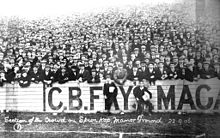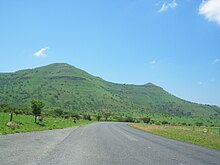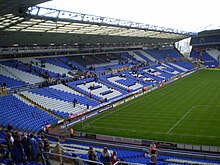
Spion Kop (or Kop for short) is a colloquial name or term for a number of single tier terraces and stands at sports stadiums, particularly in the United Kingdom.
Their steep nature resembles a hill near Ladysmith, South Africa, that was the scene of the Battle of Spion Kop in January 1900 during the Second Boer War.[1]
History

The first recorded reference to a sports terrace as "Kop" related to Woolwich Arsenal's Manor Ground in 1904.[2] A local newsman likened the silhouette of fans standing on a newly raised bank of earth to soldiers standing atop the hill at the Battle of Spion Kop. In 1906 Liverpool Echo sports editor Ernest Edwards noted of a new open-air embankment at Anfield: "This huge wall of earth has been termed 'Spion Kop', and no doubt this apt name will always be used in future in referring to this spot". The use of the name was given formal recognition in 1928 upon construction of a roof. Even though it could be the most well known, it was not the first terrace to carry the Spion Kop name; Arsenal's Manor Ground came before it.[3] Many other English football clubs and some rugby league clubs (such as Wigan's former home Central Park) applied the same name to stands in later years.
Villa Park's old Holte End was historically the largest of all Kop ends, closely followed by the old South Bank at Molineux, both once regularly holding crowds in excess of 30,000. However, in the mid-1980s work was completed on Hillsborough's Kop which, with a capacity of around 22,000, became the largest roofed terrace in Europe.
Liverpool's Spion Kop was closed and demolished in 1994 to comply with requirements of the Taylor Report, which made all-seater stadiums obligatory in the highest two divisions of English football. A new Spion Kop was built in its place with 12,390 seats.
Composition
There is much debate about what type of stand constitutes a Kop. The size and location of the stand in the stadium varies; most are located behind the goal and are occupied by its club's most vocal supporters. It is usually a single-tiered stand and is traditionally terraced. In England, safety regulations brought into effect after the 1989 Hillsborough disaster required many to be made all-seated. A Kop is not necessarily the largest stand in the stadium and does not have to have a particularly large capacity; for example, Chesterfield's former stadium, Saltergate, had a Kop with a capacity of only a few thousand.
Kopites
The supporters who sang on Liverpool's Kop helped make Anfield famous for its atmosphere.[4] "Kopites" is a collective name given to the supporters of Liverpool Football Club.[5]
Kops



References
- ^ Harvey, Oliver (16 June 2010). "How soccer home stands got Kop name from bloody Boer battle". The Sun. London. Retrieved 17 June 2010.
- ^ a b "Showdown in Durban". The Globe And Mail. Retrieved 25 June 2010.
- ^ "A Conservation Plan for Highbury Stadium, London" (PDF). Islington Council. Archived from the original (PDF) on 4 February 2012. Retrieved 20 March 2006.
((cite web)): Unknown parameter|deadurl=ignored (|url-status=suggested) (help) - ^ Duke, Greg. Football First 11: Stunning stadiums CNN. 29 October 2008.
- ^ Augustyn, Adam. The Britannica Guide to Soccer. RES 15 August 2011. "In 1906 Anfield's newly constructed terrace grandstand was christened Spion Kop for its resemblance to a hill where a famous South African War battle had been fought, which led to the well-known "Kopites" nickname for Liverpool's fans."
- ^ Pearce, James (23 August 2006). "How Kop tuned in to glory days". Liverpool Echo. Archived from the original on 10 February 2009. Retrieved 7 April 2010.
((cite web)): Italic or bold markup not allowed in:|publisher=(help); Unknown parameter|deadurl=ignored (|url-status=suggested) (help) - ^ Hadfield, Dave (3 September 1999). "Rugby League: Curtain falls on house of fame". London: The Independent. Retrieved 6 April 2010.
((cite news)): Italic or bold markup not allowed in:|publisher=(help) - ^ "derbycountyfootballhistory.co.uk". Archived from the original on 4 August 2013.
((cite web)): Unknown parameter|deadurl=ignored (|url-status=suggested) (help) - ^ "Blackpool". Football Ground Guide. Retrieved 6 April 2010.
- ^ "Sheffield United". Football Ground Guide. Retrieved 6 April 2010.
- ^ "County Ground, Northampton". Football Ground Guide. Archived from the original on 25 November 2009. Retrieved 9 April 2010.
- ^ "Preston North End". Football Ground Guide. Retrieved 9 April 2010.
- ^ "ARTISTS IMPRESSIONS – ELLAND ROAD FOR WORLD CUP". Leeds United AFC. 1 December 2009. Retrieved 30 June 2010.
- ^ "Filbert Street Leicester City". Football Ground Guide. Archived from the original on 31 December 2009. Retrieved 13 April 2010.
- ^ "Highfield Road, Coventry City". Football Ground Guide. Archived from the original on 28 March 2008. Retrieved 13 April 2010.
- ^ "The ASD Lighting Kop". Sheffield Wednesday F.C. Archived from the original on 3 January 2011. Retrieved 7 April 2010.
((cite web)): Unknown parameter|deadurl=ignored (|url-status=suggested) (help) - ^ "Notts County | Club | Meadow Lane | Meadow Lane — The Home Of Notts County FC". Nottscountyfc.premiumtv.co.uk. Archived from the original on 22 May 2008. Retrieved 7 April 2010.
((cite web)): Unknown parameter|deadurl=ignored (|url-status=suggested) (help) - ^ "My best day in 70 years as a fan, says Dickie". London: dailymail.co.uk. 17 February 2008. Retrieved 30 June 2010.
- ^ "Tranmere Rovers". Football Supporters Federation. Archived from the original on 30 December 2010. Retrieved 9 April 2010.
((cite web)): Unknown parameter|deadurl=ignored (|url-status=suggested) (help) - ^ "Wrexham". Football Supporters Federation. Archived from the original on 30 December 2010. Retrieved 9 April 2010.
((cite web)): Unknown parameter|deadurl=ignored (|url-status=suggested) (help) - ^ "Chesterfield". Football Ground Guide. Retrieved 20 April 2010.
- ^ "St Andrew's Stadium Plan" (PDF). Birmingham City F.C. Archived from the original (PDF) on 31 March 2010. Retrieved 7 April 2010.
((cite web)): Unknown parameter|deadurl=ignored (|url-status=suggested) (help) - ^ "La tribune Ouest Kop". www.rcstrasbourgalsace.fr (in French). Retrieved 24 May 2017.
- ^ "Bradford City". Football Ground Guide. Retrieved 7 April 2010.
- ^ "The Walkers Stadium". Leicester City F.C. 22 September 2009. Archived from the original on 25 January 2010. Retrieved 7 April 2010.
((cite web)): Unknown parameter|deadurl=ignored (|url-status=suggested) (help) - ^ "Alex Russell Stand reverts back to "Kop Stand" name". Linfield F.C. 4 December 2008. Archived from the original on 30 September 2011. Retrieved 30 June 2010.
((cite web)): Unknown parameter|deadurl=ignored (|url-status=suggested) (help) - ^ >"Kop Of Boulogne, une histoire devenue légende". www.lagrinta.fr. 20 October 2013. Retrieved 6 October 2015.
- ^ "Stadion". www.degraafschap.nl. 19 September 2016. Retrieved 19 September 2016.
Sources
- Inglis, Simon. The Football Grounds of England and Wales (Collins Willow, 1982)
- Kelly, Stephen F. The Kop, (Virgin Books, 2005)
- Pearce, James. How Kop tuned in to glory days, Liverpool Echo. 23 August 2006.
- Chapple, Mike. Spion Kop's mixture of myth and magic Liverpool Daily Post, 25 August 2006.
External links
- The incredible story behind the Kop Guided by local historian Raymond Heron, BBC Sport's Mark Lawrenson visits Spion Kop in South Africa.